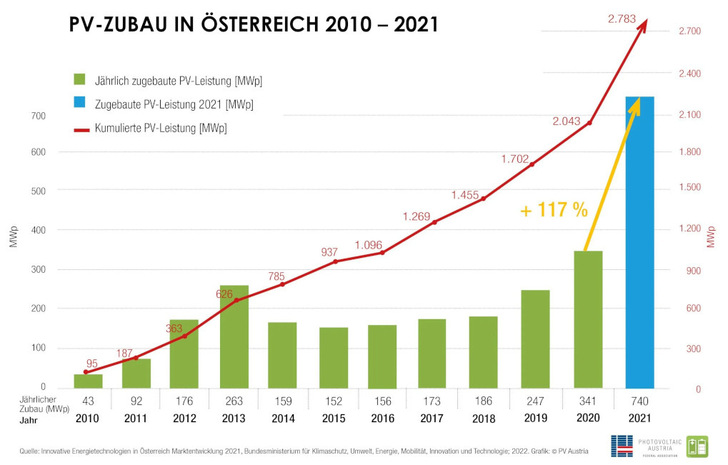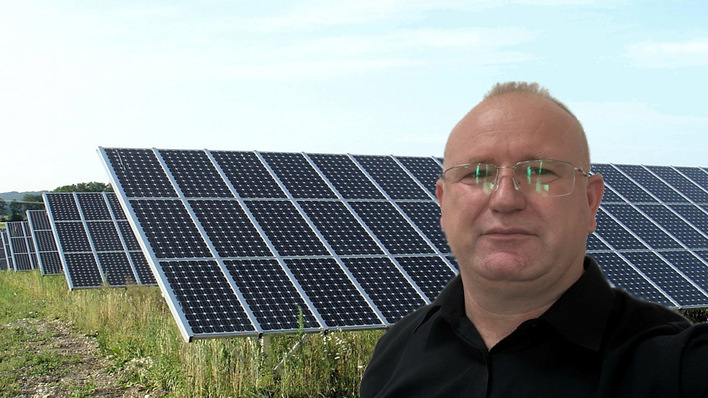According to the Austrian industry association PV Austria, solar craftsmen in Austria installed 740 megawatts of new photovoltaic systems last year. This is more than ever before in one year and an increase in annual additions of 117 per cent compared to the previous year. For comparison: in 2020, the newly installed solar power capacity was still 340 megawatts.
Motivation for more new installations
PV Austria relates the figures to the annual report "Innovative Energy Technologies in Austria, Market Development 2021", which has just been published by the Ministry for Climate Protection. "The feedback from the companies already suggested that 2021 was an extremely successful PV year. The industry has achieved incredible things in the past year!" emphasises Herbert Paierl, CEO of PV Austria "The record year 2021 must now be taken as a basis and motivation for further expansion - further expanding the output will be demanding for everyone."
Expansion path maintained
Finally, the industry is on the necessary expansion path, but it will become more ambitious every year if Austria wants to switch completely to green electricity by 2030. After all, 2,783 megawatts of solar capacity are connected to the grid in Austria, including the record expansion last year. These solar plants cover about five per cent of the electricity consumption in the Alpine republic.
Subsidies improved
The association representatives attribute the good result to the improved promotion landscape. In addition to the proven continuous subsidies from the Climate and Energy Fund, a tariff subsidy from the Ökostromabwicklungsstelle (Oemag), which had not been planned before but was then approved, is also available. For the first time, there was also additional support from the Austria Wirtschaftsservice (AWS), a federal development bank.
EAEC is only the beginning
Nevertheless, the framework conditions are far from perfect, even though the Renewable Energy Expansion Act (EAG) has already brought a lot of dynamism to the sector. "However, the Renewable Energy Sources Act alone is no saviour," warns Herbert Paierl. "Without massive grid expansion, I fear we will remain stuck in the fossil age. Important accompanying measures are still missing, such as sufficiently designated areas for photovoltaics or the acceleration of approval procedures."
Quintuple output to date
These hurdles still have to be cleared. For by 2030, the currently installed output must be increased fivefold. This means that new capacity must be increased to an average of one gigawatt per year. This is also a challenge for some of the federal states that have so far put the brakes on the solar energy transition. Because the results also show that: The federal states raise the existing potential for the expansion of photovoltaics very differently.
Highly populated states are ahead
The good thing is that so far most photovoltaic systems have been built in the federal states that have to cope with the greatest expansion, also due to the size of their area and population. The largest federal state, Lower Austria, is also in the lead in terms of new installations. Here, 195 megawatts of output were built last year. In Upper Austria, 177 megawatts of new solar capacity were connected to the grid last year. Both states now have more than 600 megawatts of output on the grid (Lower Austria 628 megawatts, Upper Austria 611 megawatts). They have thus surpassed the previous leader, Styria. There, not as many solar plants were built last year as in the other two federal states, so that the installed output is now 532 megawatts.
Federal states with a need to catch up
The western federal states and the very sunny Carinthia have an urgent need to catch up. Here, very little to nothing is happening as far as new installations are concerned. In Carinthia and Salzburg, only 15 per cent each of the expansion required for a complete switch to renewables has been achieved so far. Tyrol has actually only reached twelve per cent of the necessary 1.4 gigawatts of installed output. (su/mfo)
See also:
Energie Steiermark deploys charging technology from Ads-Tec Energy
Recycled ocean plastic solar modules for vehicle integration








